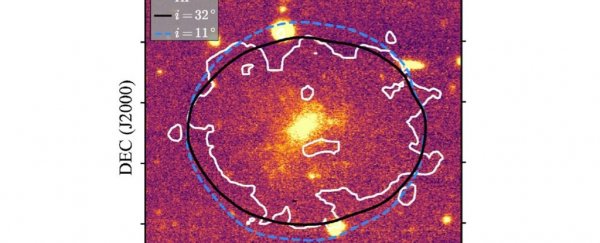Out in the dark depths of space, our models of the Universe get messy. A new study looking at the ultra-diffuse dwarf galaxy AGC 114905 has revived a controversial theory (or more accurately a hypothesis) of gravity, and given us more questions than answers about what's making our galaxies tick.
It all starts with dark matter – or in this case, no dark matter. Although most cosmologists agree there's something out there called 'dark matter', causing spiral galaxies to rotate faster than they should, even dark matter doesn't answer all the questions we need it to.
So, it's not a bad idea to look at some alternative options. You know, just in case we are never able to find the stuff.
One alternative hypothesis to dark matter is called Modified Newtonian dynamics (MOND) or Milgromian dynamics framework. This hypothesis – first published in 1983 by physicist Mordehai Milgrom – suggests that we don't need dark matter to fill in the Universe's gravity gaps, if we calculate the gravitational forces experienced by stars in outer galactic regions in a different manner to how Newtonian laws suggest.
To test this idea, which involves working with proportionality to the star's radius or centripetal acceleration, we need to be looking at the speeds of galaxies – specifically weird ones like ultra-diffuse galaxies.
These very faint, ugly ducklings of the galaxy world have a habit of not acting like a galaxy should. For example, some ultra diffuse galaxies seem to be made almost entirely of dark matter, whilst others are almost completely dark matter-less.
This is where AGC 114905 comes in. This ultra-diffuse dwarf galaxy around 250 million light years away had recently been looked at in detail in a paper published in 2021 investigating how fast it spins.
But this team found that the galaxy's spin was extremely slow – slow enough that not only did they not need dark matter to confirm the models, but the rotation curve of the galaxy also cast huge doubt on the MOND framework. It doesn't fit with either hypothesis.
"The very low reported rotation speed of this galaxy is inconsistent with both MOND and the standard approach with dark matter," says University of St Andrews physicist and one of the researchers of the new paper, Hongsheng Zhao.
"But only MOND is able to get around this apparent contradiction."
The new paper has 'un-debunked' the 2021 finding, suggesting that the issue isn't with MOND, but instead with the inclination of the galaxy itself.
When we look at galaxies far away in the depths of space, it can sometimes be hard to confirm which angle we're seeing. The original team found that AGC 114905 looked elliptical, suggesting that we're looking at the galaxy from an angle.
But using simulations, researchers now suggest the galaxy could appear elliptical even when it's facing us straight on. A change in the angle of the galaxy to us would also change how fast the galaxy is rotating, making all the MOND math add up after all.
"Our simulations show that the inclination of AGC 114905 might be significantly less than reported, which would mean the galaxy is actually rotating much faster than people think, in line with MOND expectations," says lead author of the new paper, physicist Indranil Banik, also from the University of St Andrews.
Now, this is still an open question. We don't know whether this new paper, or the 2021 paper is going to be crowned victorious – or at least most correct.
In the meantime, if this new finding holds, it seems that the MOND framework might live on for another day. As wild as MOND might be, with dark matter still elusive, and many other questions still to be answered, we need all the options we can get.
The research has been published in the Monthly Notices of the Royal Astronomical Society.
